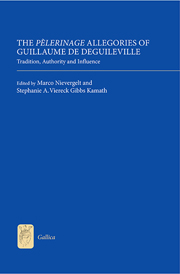Book contents
- Frontmatter
- Contents
- List of Illustrations
- List of Contributors
- Acknowledgements
- Abbreviations
- Introduction
- Part I Tradition
- 1 The Pèlerinage corpus: A Tradition of Textual Transformation across Western Europe
- 2 Manuscrits à voir, manuscrits à lire, manuscrits lus: les marginalia du Pèlerinage de Vie Humaine comme indices de sa réception médiévale
- 3 Rewriting Joseph in the life of christ: The Allegory of the Raptor-Thieves in the Pèlerinage de Jhesucrist
- Part II Authority
- Part III Influence
- Bibliography
- Index
2 - Manuscrits à voir, manuscrits à lire, manuscrits lus: les marginalia du Pèlerinage de Vie Humaine comme indices de sa réception médiévale
from Part I - Tradition
Published online by Cambridge University Press: 05 December 2013
- Frontmatter
- Contents
- List of Illustrations
- List of Contributors
- Acknowledgements
- Abbreviations
- Introduction
- Part I Tradition
- 1 The Pèlerinage corpus: A Tradition of Textual Transformation across Western Europe
- 2 Manuscrits à voir, manuscrits à lire, manuscrits lus: les marginalia du Pèlerinage de Vie Humaine comme indices de sa réception médiévale
- 3 Rewriting Joseph in the life of christ: The Allegory of the Raptor-Thieves in the Pèlerinage de Jhesucrist
- Part II Authority
- Part III Influence
- Bibliography
- Index
Summary
Résumé en anglais/Abstract in English
The success encountered by Deguileville's Pèlerinages in the Middle Ages is undeniable, as attested by the numbers of surviving manuscripts. Yet manuscript numbers alone reveal very little about the nature of these texts' reception. Were these manuscripts read in extenso, or more discontinuously and selectively, or were they admired as a vehicle for lavish illumination? Who read the texts, in what manner and to what end? Although many manuscripts are indeed abundantly illustrated, more than fifty copies of PVH carry marginal annotations dating from the Middle Ages: the first of the Pèlerinages was thus not only the most widely circulated but also seems to have attracted the greatest amount of marginalia. Surveying the ‘tradition’ of annotation offers us a more informed understanding of the successful circulation of Deguileville's corpus.
PVH manuscripts display a wide variety of different types of annotation, both in Latin and in the vernacular, ranging from scribal annotations or rubrication to more discreet marks and comments supplied by later readers. The general tenor of annotations confirms that PVH was held in high regard during the fourteenth and fifteenth centuries. Indeed, annotations are invariably non-polemical, and often highlight text extracts that readers seem to have found particularly edifying; exempla, proverbs, the author's elucidations of his own allegorical vocabulary and didactic narrative passages tend to attract more annotations than abstract and speculative episodes and, interestingly, annotations are found in relatively uniform density across the whole of PVH1.
- Type
- Chapter
- Information
- The Pèlerinage Allegories of Guillaume de DeguilevilleTradition, Authority and Influence, pp. 47 - 64Publisher: Boydell & BrewerPrint publication year: 2013

